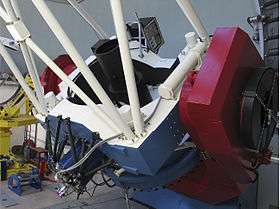Gamma-Ray Burst Optical/Near-Infrared Detector
The Gamma-Ray Burst Optical/Near-Infrared Detector (GROND) is an imaging instrument used to investigate Gamma-Ray Burst afterglows and for doing follow-up observations on exoplanets using transit photometry.[1][2][3] It is operated at the 2.2-metre MPG/ESO telescope at ESO's La Silla Observatory in the southern part of the Atacama desert, about 600 kilometres north of Santiago de Chile and at an altitude of 2,400 metres.

GROND mounted on the MPG/ESO telescope (a dark blue cylinder at the lower left)
Discoveries
- On 13 September 2008, Swift detected gamma-ray burst 080913. GROND and VLT subsequently placed the GRB at 12.8 Gly distant, making it the most-distant GRB observed, as well as the second-most-distant object to be spectroscopically confirmed.[4][5]
- On 15 September 2008, NASA's Fermi Gamma-ray Space Telescope detected gamma-ray burst 080916C. On 19 February 2009, NASA announced that the GROND team's work shows that the GRB was the most energetic yet observed, and 12.2 Gly distant.[6][7]
gollark: Is it *actually* 100 kilodollars? If so, surely you could make lots of money by renting AWS capacity, or something.
gollark: "Doing the correct things instead of the incorrect things: a guide"
gollark: "Virtue and self-reliance for fun and profit"
gollark: Partly because people tend to write about whatever works for them as if it is the magic solution to all things ever.
gollark: I feel like self help is an incredibly overdone genre.
See also
- Red shift observations in astronomy
- Photometry (astronomy)
- Max Planck Institute for Extraterrestrial Physics
References
- Snellen, I. A. G.; Koppenhoefer, J. (2008). "OGLE2-TR-L9b: an exoplanet transiting a rapidly rotating F3 star" (PDF). Astronomy & Astrophysics. 497: 545–550. arXiv:0812.0599. Bibcode:2009A&A...497..545S. doi:10.1051/0004-6361/200810917.
- http://www.aanda.org/articles/aa/full_html/2012/03/aa18336-11/aa18336-11.html
- "GROND Takes Off" (Press release). European Organisation for Astronomical Research in the Southern Hemisphere (ESO). 2007-07-06. Archived from the original on 2009-02-25. Retrieved 2009-02-23.
- "NASA's Swift Catches Farthest Ever Gamma-Ray Burst" (Press release). NASA. 2008-09-19. Retrieved 2009-02-23.
- Greiner, Jochen; et al. (2008-10-13). "GRB 080913 at redshift 6.7". The Astrophysical Journal. 693: 1610–1620. arXiv:0810.2314. Bibcode:2009ApJ...693.1610G. doi:10.1088/0004-637X/693/2/1610.
- "NASA's Fermi Telescope Sees Most Extreme Gamma-ray Blast Yet" (Press release). NASA. 2009-02-19. Retrieved 2009-02-23.
- Greiner, Jochen; et al. (2009-02-04). "The redshift and afterglow of the extremely energetic gamma-ray burst GRB 080916C". Astronomy and Astrophysics. 498: 89–94. arXiv:0902.0761. Bibcode:2009A&A...498...89G. doi:10.1051/0004-6361/200811571.
This article is issued from Wikipedia. The text is licensed under Creative Commons - Attribution - Sharealike. Additional terms may apply for the media files.